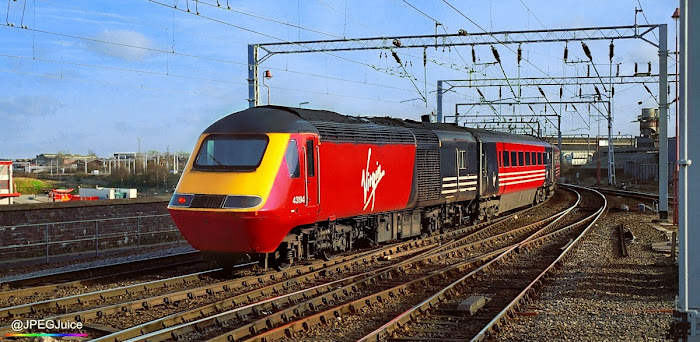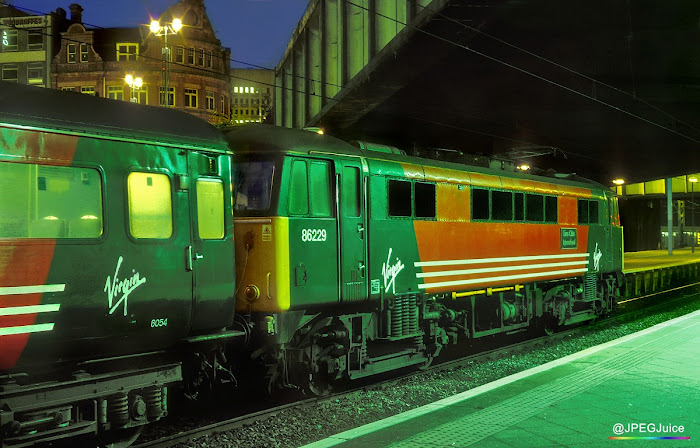Chiltern Class 168 - The Early Years
The story of the post-BR era's first new trains, in their initial ten years.

At Tyseley station on 28th April 1999, 168003 models the original Class 168/0 livery with non-contrasting doors.
It appeared that, had they not made history as the first post-British Rail motive power to enter service, the Class 168 'Clubman' units would have received no more than a pictureless footnote in the late '90s magazines...

The updated, post-2003 version of the Chiltern white/blue Class 168/0 livery, with contrasting doors, seen on 168005 at Bentley Heath, 12th July 2006.
BACKGROUND
The 168s' grand entrance came at a time when the magazines were overwhelmed with demand for coverage of the huge but imminently endangered stocks of ex-BR freight diesels. And even in their moment of historical achievement, the 168s were wildly overshadowed by the EWS Class 66s.
A Railway Month in Pictures: February 2001
"Through the latter part of the month, the whole country commenced a farmland shutdown, which affected a huge number of public footpaths and saw many popular railway photography vantage points labelled out of bounds."

Virgin Trains 43194 at Wolverhampton.
If you keep a diary and you were a UK railway enthusiast at the beginning of the century, you may notice quite a downbeat tone across your February 2001 entries. For the first time, signs of the homogenised future heralded by privatisation were starting to show, and the horizon was far from golden.
With the Class 175s finally up and running, January 2001 had seen the last of the Class 37-hauled services between Birmingham and North Wales. Meanwhile, another looming threat to old stock became a reality on 8th Feb, when the first Pendolino - 390001 - left Alstom Washwood Heath behind 66087, for testing at Ashfordby. The following day, the final three EWS Class 31s were withdrawn from regular service at Old Oak Common. And the following week, engineering work between Exeter and Newton Abbot shut down services in the West Country.
Tug Aesthetica: Making Sense of the Class 60's Earlier Visual History
"Most Loadhaul Class 60s remained either in full Trainload livery, or had the Trainload decals removed to render an unbranded triple-grey look."

Battling the Arctic-style conditions of New Year's Day 2002, 60034 flies the flag for Transrail grey livery.
With thanks to those who shared links to my Class 60 article last week, I'm making this payback time. Yes, I've dug deep into my photo archives to bring forth another selection of visual Class 60 studies - mainly from the long-lost era of film.
The theme this time is an exploration of the standard Class 60 aesthetics that sat across the transitional period from late British Rail into early privatisation. Did you know that the first Class 60 EWS repainted was not initially released in red and gold? Did you know that the 60s have a "clean end" and a "dirty end"? Have you ever wondered why so many 60s were stripped of their original nameplates in the 1990s? If not, don't worry. It's all coming up in this very post. And if you're just here for the nostalgic images, there's plenty here that the world has never before seen...
British Rail's Class 60 in the EWS Years
"One really interesting use of a Class 60 that encapsulated the transience of EWS cascading, was the Lickey banking duty."

60076 in the EWS-branded version of BR's triple-grey livery, with a Round Oak - Margam run on 6th June 2007.
They still felt new. It just wasn't what we were expecting to happen...
If any locomotive type seemed safe from the effects of post-BR renewal, it was the Class 60. Reassuringly bulky, with monster tractive effort, the Brush/Mirrlees Type 5s were a product of the late 1980s, starting service in the early 1990s, and the last of them had not been ready to run until 1993. Just three years later, the locomotive order which would rapidly end their reign of UK freight supremacy was signed and sealed.
The Complicated World of Modern Traction Naming
"British Rail did not name any locomotives at all between the beginning of 1967 and the end of 1975. That's nine full years without any namings. Just let that sink in for a moment. Nine years."

Onto its second name... 86229 was originally named Sir John Betjeman in mid 1983. It was renamed Lions Clubs International whilst with Virgin West Coast fifteen years later. This shot shows the loco at Birmingham New Street on 15th November 2001.
If we're talking about classic diesel traction and I refer to Merddin Emrys, do I mean 47281, or do I mean 47145? If I reference Petrolea, do I mean 47374, or 37888, or 58042?... Unless we already have a context, you won't know. That's because these example names appeared on all of the loco options I've cited. Over the years, locomotive and train names have been fairly casually recyclable, or transient in their association with particular items of stock. Does that defeat the point of naming?
What, indeed, even is the point of naming? Who or what is it for? Is it for the rail enthusiast? For the wider public? For the person, group or entity honoured in the name? Or is it for the media, and ultimately for the publicity benefit of the train operator? Is naming about respect? And if so, does that respect extend to the actual loco or train? Is it about schmoozing? Is it about virtue signalling? Is it merely an honest attempt to add kudos to rail travel?... It would be naive to think it's not to some extent about the train operator drawing attention to itself. But has that quest, at times, been a little too obvious?...
